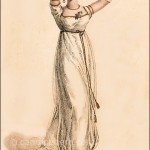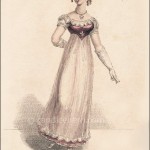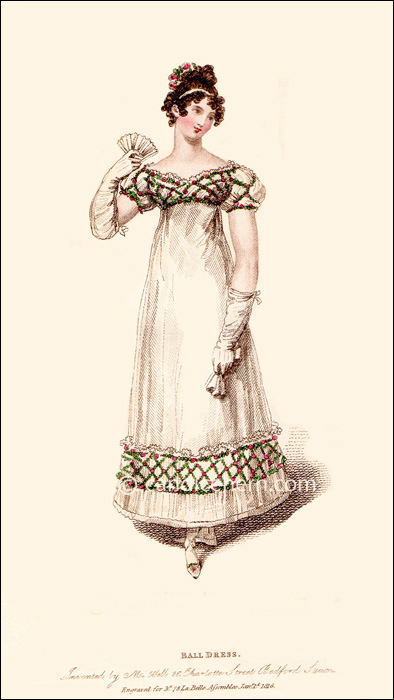The British Lady’s Magazine, October 1817.
“Ball Dress.”
Skirts have generally become shorter by 1817, and ball dresses are almost always shown with shorter hems than the evening full dress, but one has to wonder if this short hem is somewhat exaggerated. Perhaps to show off the charming dancing shoes?
Waistlines are also at their highest in 1817-1819 before they start gradually dropping to the natural waist in the 1820s. But this bodice is very, very tiny. Like the hemline, it may also be an exaggeration. It is definitely unusual to see so much bosom in British prints. Prints from other magazines showing the teeny tiny late Regency bodice do not show so clearly the swell of the bosom and well-defined cleavage.
The print is described in the magazine as follows:
“BALL DRESS of blue crape, slashed with a white satin French ribbon with a beaded edge, continuing from the top of the dress body to the bottom of the petticoat, and finishing with a shell border; body [ie bodice] and sleeves to correspond, tied up to the shoulder with a French ribbon; a long sash of the same to fasten behind the hair, dressed high on the forehead with a large French bow on the top of the hair, and bird of paradise plume. Shoes of blue, and gloves of white kid. Topaz ornaments. Fan of beautiful pink ivory.
“The dresses are still worn very full, the waists short, and the petticoats much longer. The prevailing colours are blue, green, and mushroom.”
In the Observations on Dress, the following is stated, which seems to emphasize the style of dress in the print as the height of fashion:
“For Evening Dress, or for balls, operas, or conversationes, nothing is so highly elegant as coloured crape Dresses, slashed both in body and skirt with a white loose-edged satin ribbon, forming at the bottom a tasty border of various devices: the colour now most sought after by the Ladies of the haut ton is that pretty blue, which has so long distinguished the blue bell of Scotland.”








